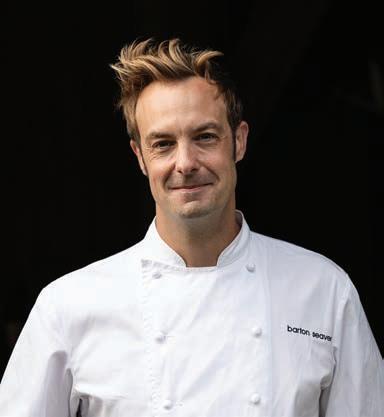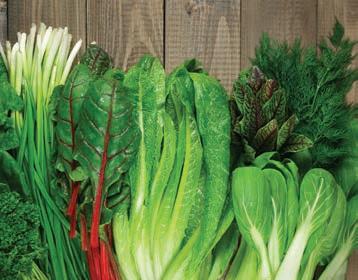
7 minute read
ONES TO WATCH
from National Culinary Review (Jan/Feb 2023)
by National Culinary Review (an American Culinary Federation publication)
These top emerging trends bear scrutiny as they could portend future hot trends. Global influences play a strong role in many of these potential up-and-comers. Diners, especially Gen Zs who are starting into their earning years, like to sample — and post about — breakthrough foods and flavors.
• G lobally inspired sandwiches (Chinese rou jia mo or jianbing, Argentine choripan, etc.)
• New sandwich carriers (paratha, roti, pastry buns, crepes, etc.)
• Amazake (Japanese drink made from fermented rice)
• Alfajor (sweet of almond paste, nuts, breadcrumbs and honey)
• Balkan (Croatian, Bulgarian, Turkish, etc.)
• R aki (Turkish alcohol made of twice-distilled grapes and anise)
• Automation technology (monitoring volume, temperature and time)
• Hawaiian haupia (coconut pudding)
• Huacatay (Peruvian black mint sauce)
• Elevated breakfast bowls (breakfast rice bowls, breakfast pasta bowls, etc.)
Cooling Down
• Pickle pizza
• Breakfast salads
• Fried lasagna
• Balsamic cocktails
• Fruit-flavored coffee (e.g., banana, etc.)
• Pickled French fries
• Ranch water
• Upscale pigs-in-a-blanket
• Name-brand snacks (i.e., retail incorporated into restaurant recipes)
• Crudité platters
If there’s one group that leads and influences the food system, it’s chefs. Consider this role and you realize the immensity of it: As providers of food, our behaviors affect quality of life, quality of our environment as it relates to climate change and the very ability of our species to thrive.
We know that dietary choices affect our health in general, but increasingly, research is linking those choices to our brain health in particular. That’s of note, considering more than six million of all Americans have Alzheimer's disease, according to the Alzheimer’s Association. By 2050, the number of people aged 65 and older with Alzheimer's and dementia is projected to reach 12.7 million — unless scientists develop new cures or approaches to prevention, as reported by the BrightFocus Foundation. Just this year, there will be an estimated 500,000 new cases of Alzheimer’s disease, and that doesn’t include other neurodegenerative diseases like frontotemporal dementia and others.

On a positive note, more studies are showing a strong correlation between plant-based food and healthy brains. Conversely, there’s a correlation between ultra-processed food — that is, food containing preservatives, additives and many ingredients that aren’t food — and cancer, obesity, diabetes and cardiovascular disease, as well as cognitive issues like dementia. “Research shows that no matter what kind of ultra-processed food you pick, it’s less healthy than cooking from scratch,” says Dr. Rani Polak , founding director of the CHEF Coaching program at the Spaulding Rehabilitation Hospital’s Institute of Lifestyle Medicine at Harvard Medical School. “If you really want to take care of yourself and your brain, you should cook from scratch as much as possible.”
The definition of from-scratch cooking doesn’t necessarily rule out restaurants — rather, it suggests avoiding ultra-processed food in whatever you eat, be it a meal at a fast-food eatery or the processed vegan burger on your processed bun at lunch. “We know that when people eat out, they tend to eat ultra-processed food,” Polak says. “We also know that people consuming [whole, unprocessed] plant-based food have a lower risk of dementia, and that when they make good nutritional choices, they are healthier overall.” That said, chefs are in a unique position to offer their clientele, especially middle-aged and older customers, more clean nutritious choices to ward off long-term diseases of all types.
ACF Chef Barton Seaver, a former restaurant chef, sustainable seafood advocate, author of seven books and the former director of Harvard School of Public Health’s Sustainable Seafood and Health Initiative, agrees. “It’s becoming increasingly obvious that the right choices for our life span are also the right choices for our health span, and that those two meet in a diet rich in plant-based foods,” he says. “What’s really compelling is that the answer to so many of the critical issues we’re looking at — food justice, equity, inclusion, health, nutrition and climate change — is a diet based mostly in plants, reduced consumption of red meat and adequate consumption of seafood.”
Trouble is, chefs in general represent some of the most unhealthy lifestyle choices, he notes, including lack of sleep, long work hours, substance abuse, suboptimal dietary choices and high levels of stress. “We know these are all indicators of negative public health outcomes, so for this industry to take a stand from within and to show that brain health and overall lifestyle health is so fundamentally important to us, makes us the heroes of this conversation,” Chef Seaver says. “We have to put those same solutions on the plates we serve.”
The bottom line, he continues, is that for the first time, “we’re rethinking the purpose of food and realizing it’s quality of life, quality of experience, quality of the environment and health of the communities we live in.”
Clean Cooking
How can chefs make a difference in the lives of the people they feed? There are many ways to be proactive, Polak says.
For starters, “do more cooking from scratch and use less ultra-processed food in your restaurant,” he says. This can be challenging in higher-volume operations, so start with baby steps, he recommends. “Experiment with making a burger yourself, for example, and once that becomes easy and effortless, think about the next change, perhaps the barbecue sauce. It can be an ongoing effort, and it doesn’t need to be one big change at once.”
From there, to make meals even healthier for our brains, consider using less fat and cooking at lower temperatures. “One good example of the importance of cooking temperature is when cooking animal proteins,” Polak says. “Research shows that cooking temperature is correlated with advanced glycation end products, which potentially contribute to inflammation.”
To learn more techniques for cooking highly nutritious meals at different types of operations, Polak encourages chefs to consider participating in the CHEF Coaching program offered at Harvard Medical
School’s Spaulding Rehabilitation Hospital. It’s a program directed to both clinicians and chefs who are passionate about educating patients or the public about expanding home cooking to improve nutrition and overall health. The program also combines culinary training with health and wellness coaching competencies.
Serve More Seafood
“Simply put, put more seafood on more plates more often,” Chef Seaver suggests if there’s a focus on brain health, especially for aging clientele in healthcare, senior living and even country clubs, but also for younger consumers at the college/university level. “We know a reduction in red meat and increased consumption of omega-3-rich seafoods leads to incredible positive public health outcomes,” for example, less burden on healthcare systems and less time taken off of work. Needless to say, seafood is a great way to be able to showcase high-level culinary abilities, he adds, “and shows that I truly care about those I serve.”
Bigger Ain’t Better
It's also prudent to examine your portion sizes. American consumers have long been taught that bigger portions and more food equate with better value, leading to a marked tendency to overeat. Educating diners that less is best won’t be easy, but it’s necessary for healthy living and for a healthy, sustainable environment.
“Anything over four ounces of protein is a waste,” Chef Seaver says unequivocally. “The body simply doesn’t need any more than that. So from a health and environmental sustainability standpoint, let’s give people what they actually need and then wow them with all the vegetables, colors, tastes and textures we come up with to showcase those proteins.” With today’s rising food costs, cutting portions presents a win-win for both operator and consumer.
Re-Centering The Plate
When it comes to wowing your diners, the place to start is the menu construction itself, where the protein is usually emphasized at the expense of everything else. “Re-think this center of the plate,” Chef Seaver says. “Change starts with the very structure of our menus, where proteins are usually listed in 12-point bold typeface and everything else is in 10-point regular typeface. From the very construction of the mental image of the plate, we’ve put protein front and center. But what gives us talent as chefs is not the chicken or salmon, but everything that goes with it and showcases what we want to do with food.”

For example, if grilled salmon is the headline and miso-braised Brussels sprouts with crispy chickpeas and Asian herb salad trails off in smaller font, equalize all of it, Chef Seaver suggests. “By changing the structure of how we communicate our dishes, we can achieve decreased food costs, increased healthfulness and nutrition, greater profitability and a greater satisfaction at our role as chefs, both in our creative endeavors and in the lives of the people we serve. Anyone can put Alaskan salmon on a plate, but what makes you, you? Have confidence in that and sell it up!”
Changing how we eat and what ingredients we cook with is far from easy and demands unlearning some bad habits, from recognizing previously excessive portion sizes to not reaching for the easiest solution on the shelf. But it’s direly necessary for our brain health and for the health of our planet, Chef Seaver says.
“Brain health tops the list of the global disease burden but is often not considered because it’s a non-communicable disease, so it doesn’t often play into food policy conversations or decisions,” he says. “But this issue affects us all the way from preconception to the last days of our lives. It’s essential for us as a culinary community to take the lead in addressing this drastic gap between understanding the importance of brain health and dietary and lifestyle choices.”
It’s a huge responsibility with heady implications, and it may seem like a tall order to fulfill when you’re just serving entrees at lunch. “But make no mistake, we are part of this system and we have an opportunity to change it from within,” he says.
Fit For Our Brains
According to Harvard Health Publishing (Harvard Medical School), these are the top foods for improving the health of our brains and warding off neurodegenerative diseases.
• Green, leafy vegetables. Kale, spinach, collards and broccoli have brain-healthy nutrients like vitamin K, lutein, folate and betacarotene shown to help slow cognitive decline.

Fatty fish. Choose varieties low in mercury but high in omega-3 fatty acids, such as salmon, cod, canned light tuna and pollock.

• Berries. Flavonoids found in strawberries, blueberries, raspberries and blackberries are found to help improve memory. One study by researchers at Harvard’s Brigham and Women’s Hospital found that women who consumed two or more servings of strawberries and blueberries each week delayed memory decline by up to two-and-ahalf years.
• Tea and coffee. A 2014 study published in the Journal of Nutrition found that participants with higher caffeine consumption scored better on tests of mental function; another study found that no more than 200 milligrams of caffeine might also help solidify new memories.
• Walnuts. While nuts provide an excellent source of protein and healthy fat, a 2015 study from UCLA linked the consumption of walnuts in particular to improved cognitive test scores. Flaxseeds and chia seeds are also strong sources of plant-based, omega-3-rich fatty acids.
WeAreChefs.com










